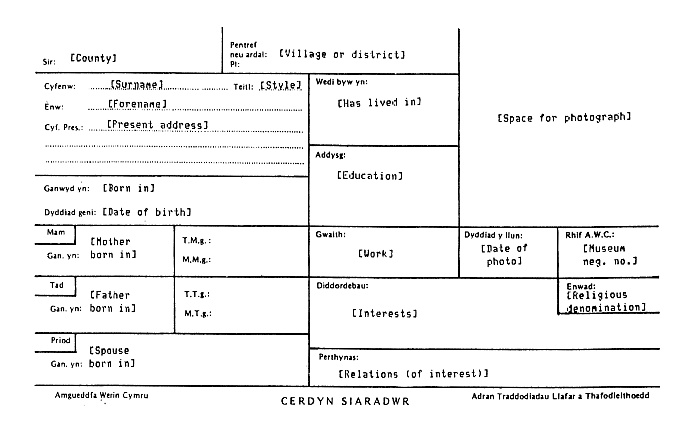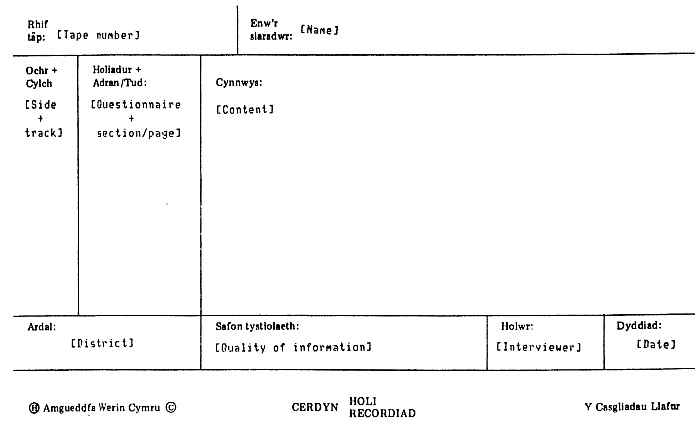Collections of folklife and language recordings
Case Study: Arngueddfa Werin Cyrnru (Welsh Folk Museum), Cardiff, Wales.
(a) Collection
The collection comprises over 3,750 hours, 85% of which is speech, consisting mainly of folklife recordings made by Museum staff.
(b) Cataloguing Staff
The ten or so members of the Museum staff who make field recordings (and who generate in all about 200 tapes per year) are responsible for preparing summaries of their own recordings. A central section of three people (one graduate, one assistant and one typist), who also have other responsibilities, manages all registration and central indexing work and prepares summaries for tapes that are not properly documented (see gi).
(c) Catalogue
A card catalogue is maintained within the Museum. There are no published catalogues.
(d) Catalogue System
The catalogue is based on two types of card: cards for speakers, arranged alphabetically and containing biographic information, and cards for interviews, arranged numerically and containing tape summaries. The card catalogue is supplemented by transcripts etc. (see gii).
(e) Indexes
The dual nature of the central catalogue makes it partially self-indexing. In addition, optical feature cards are used in a 'post-coordinate' indexing system controlled by a bi-lingual thesaurus of keywords developed by the Museum. Specialist indexes appropriate to their own research are generated by individual field workers.
(f) Examples
i. The front of a speaker card is illustrated in Figure 2. (Headings are in Welsh; English translations have been supplied.) The reverse of the card lists the tapes that contain interviews with the speaker, and provides spaces to describe or evaluate the speaker's suitability for interview, usage of the Welsh language, etc. Eleven headings are provided, including 'Correctness of language'; 'Sociability'; 'Memory'; ' Pronunciation'.

Figure 2
ii Figure 3 shows the front of an interview card. The reverse of the card continues the list of contents and provides space for entries on 'Place of recording'; 'Personality and atmosphere'; 'Additional voices on tape'; 'Purpose of recording'; 'Value of recording'; 'Sound quality'.
 Figure 3
Figure 3
(g) Comments
i. Recordings at the Amgueddfa Werin Cyrnru represent 'research in progress' for Museum staff -as distinct from, for example, the project-based work of the Imperial War Museum. The documentation supplied by field workers is therefore analogous to research notes. The central cataloguing staff is considered to be of about the right size, although a team of this size without other responsibilities would be better still.
ii. The dual card catalogue is a clever solution to a significant problem in cataloguing field recordings (especially of speech) -their tendency to generate catalogue entries of great length, which can make the design of a single catalogue card difficult. On the other hand, this system, which also includes an accession register in which some biographic information is recorded, must involve some duplication of effort. Note also the quantity of subjective evaluation anticipated by the cards. Although quite appropriate to research notes, this sort of entry would not normally be expected in a catalogue to which there was to be much public access and in fact access to the catalogue is restricted to approved users only.


